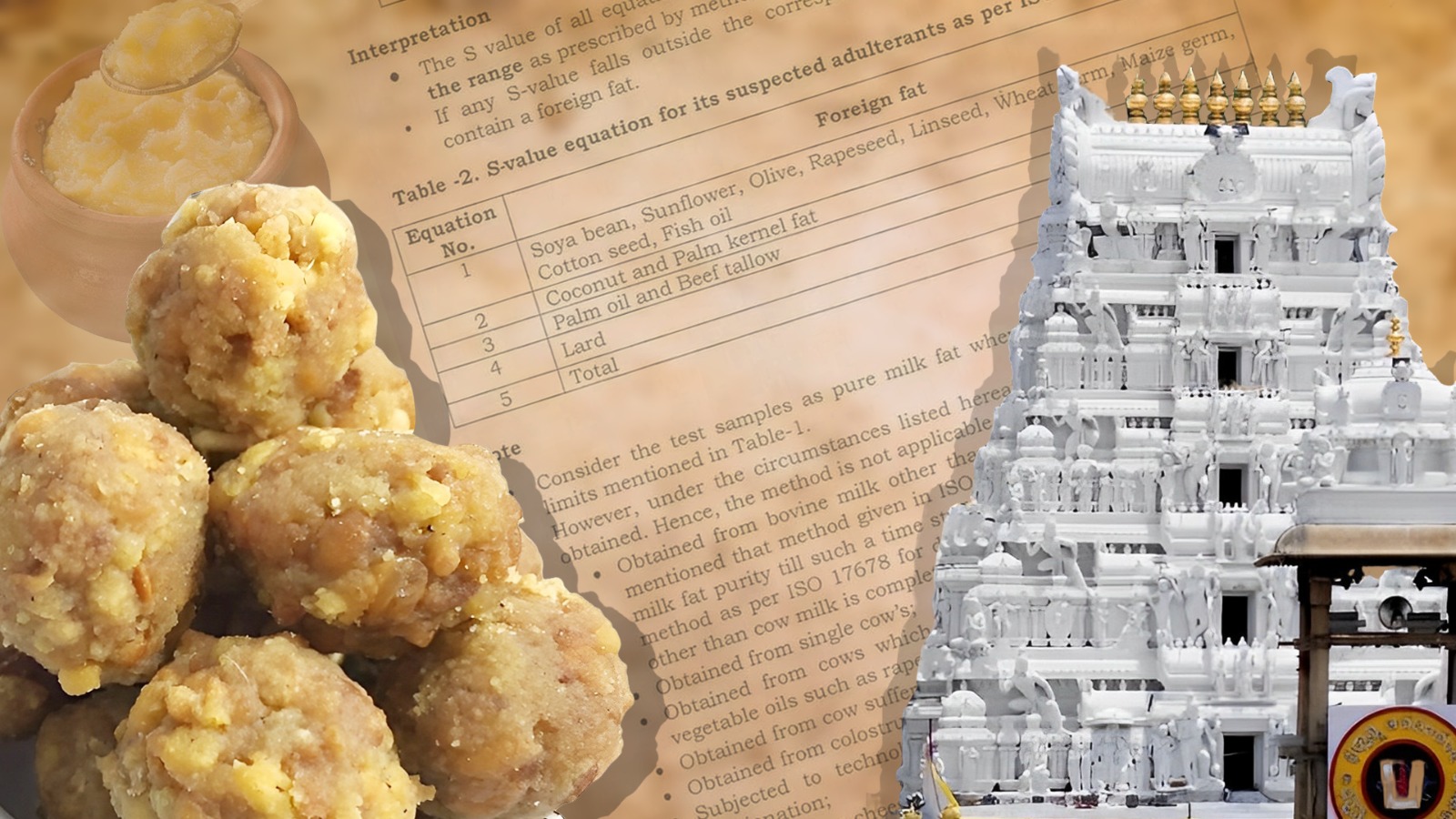Amid Andhra CM's claims of animal fat in Tirumala laddu creating a furore, we take a look at the rich cultural history of Tirupati temple - one of the most visited pilgrimage sites and the significance of the iconic sweet served as prasadam.
Published Sep 21, 2024 | 7:00 AM ⚊ Updated Nov 26, 2024 | 2:48 PM

Illustration on the controversy over animal fat in Tirupati laddu
Sri Venkateswara Swamy Temple in Andhra Pradesh is one of the most visited pilgrimage sites in the world. Steeped in history, the Tirumala temple is renowned for the iconic Tirupati laddus, offered as prasadam to devotees after darshan.
Recently, Andhra CM Chandrababu Naidu claimed that animal fat was used in laddus during the YSRCP regime, creating quite a controversy. While lab reports point to adulteration, the Executive Officer of TTD has categorically identified the adulterant as Vanaspati. In light of this, here is looking at the rich cultural history of the Tirumala temple and the significance of Tirupati laddu.
The temple’s origins can be traced back thousands of years. If one goes by the legends mentioned in the Tirumala Tirupati Devasthanams (TTD) website, Lord Sri Venkateswara – who is also known as Balaji or Srinivasa – made Tirumala his abode around 5,000 years ago.
Spanning several generations, devotees from several regions contributed to the construction and expansion of the grand temple complex, which now spans 16.2 acres of land.
Perched on the seventh peak of the Seshachalam Hills, the temple is often fondly referred to as the “Temple of Seven Hills” and stands 853 meters above sea level. The hills represent the seven heads of Adisesha, the cosmic serpent from Hindu mythology. The temple’s architecture is of Dravidian style, with the Garbhagriha (Sanctum Sanctorum), called Ananda Nilayam houses the main deity in a standing posture.
This ancient structure, with its intricate carvings and towering gopurams (entrances), was constructed over a span of long time starting from 300 AD.
As one of the eight Vishnu Swayambhu Kshetras and the 106 Divya Desams (sacred place) spread across India, the temple holds immense significance for followers of the Vaishnavite tradition. At present, the Tirumala temple is widely regarded as one of the richest temples in the world, with millions of devotees standing in long queues to offer prayers and donations.
The administration of the Tirumala Venkateswara Temple is managed by the Tirumala Tirupati Devasthanams (TTD), an autonomous board that oversees the day-to-day functioning and governance of the temple. The TTD was formed in 1933 by Madras Presidency, (now the state of Tamil Nadu) to take charge of the temple’s finances, properties, and activities.
Today, the TTD is run by a Board of Trustees, who are appointed by the Andhra Pradesh state government. The Executive Officer, who is the chief administrator of the TTD, manages the temple’s operations with the assistance of a team that includes Joint Executive Officers, Chief Vigilance and Security Officer, Financial Advisor, Conservator of Forests, and Chief Engineer.
In addition to managing the Tirumala Temple, the TTD is responsible for 12 other temples and sub-shrines in the region. The organisation employs around 14,000 people to ensure the smooth functioning of all temple-related activities, including rituals, security, and the preparation of the laddus.
Tirupati laddu, a sweet offered as Naivedyam (food offered to God), is as famous as the Tirumala temple itself. The practice of offering laddu to Lord Venkateswara at the Tirumala Temple started on 2 August 1715. The sweet is offered as prasadam to devotees, after they take blessings from the Hindu deity.
Prepared in the kitchen situated inside the temple called Potu, the laddu is crafted from simple ingredients like Bengal gram flour, sugar, cow ghee, nuts, raisins, and cardamom. How the laddu is prepared is deeply interlinked with devotees’ religious belief.
The Potu, located just outside the main temple complex, is where the laddu-making process begins. First, boondi is prepared by frying droplets of batter of Bengal gram flour in ghee in open frying vessels and the fried boondi is carried into the second Potu located in the Sampangi Pradakshinam of the temple. There, laddus are prepared using sugar syrup, ghee and other ingredients, which are then air dried and distributed to the devotees as prasadam.
The process is carried out in batches, known as Dittams, and each batch produces around 5,100 laddus. Every day, about 3.5 lakh laddus are prepared and distributed to pilgrims. A laddu of normal size (175 g) has about 40 grams of cow ghee and 40 grams of Bengal gram flour, 70 grams of sugar and other condiments.
While the quality of all the ingredients are equally important in determining the laddu’s quality, the quality and aroma of ghee is a significant factor. Hence, the procurement of good quality cow ghee becomes essential to prepare laddus of the desired quality.
The Tirumala temple offers laddus in three sizes devotees, according to Tirupati Balaji Travels.
These laddus have received Geographical Indication (GI) status, making the Tirumala Tirupati Devasthanams the exclusive authority to produce and distribute them. This ensures that the sacred laddus are of the highest quality and preserves their unique identity.
(Edited by Neena)
